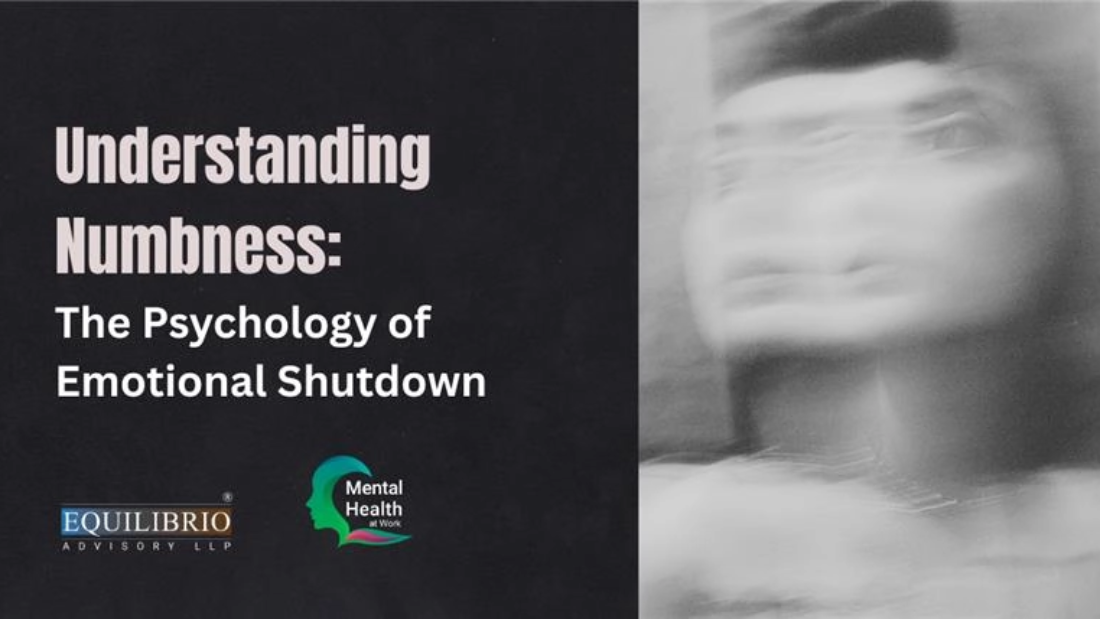There is a very famous song by the legendary band, Pink Floyd titled “Comfortably Numb”. It starts with “Hello, Is there anybody there? Just nod if you can hear me, is there anyone home.” and the chorus goes on to say, “I have become comfortably numb”.

This is the perfect way to describe what happens when people say that they are feeling NUMB.
Some of the common refrains that people verbalize when experiencing numbness are:
“I can’t feel anything. Neither happiness nor sadness”.
“I am feeling detached from everything and everyone”.
“I feel like I am just going through the motions of life, there is no real interest in anything”.
“Activities that gave me so much joy earlier, don’t seem to matter anymore”.
“I feel so empty!”
“It’s almost like I’m dead inside.”
“Nothing’s wrong per se. I just don’t seem to care.”
When people share such experiences, what they are describing is being emotionally numb.
What is numbness?
Numbness is the body’s automatic response to physical or emotional pain – considered to be part of the “freeze response” linked to the survival instinct. The freeze response is considered a part of the brain’s limbic system or trauma response mechanism, where an individual just goes immobile until a perceived threat is diffused or removed.
To protect yourself from being hurt again, it’s not uncommon to unconsciously disconnect, detach, or numb out feelings related to the situation. This disconnect is not only on the emotional but also on a physical level. In clinical terms, this feeling of being disconnected from one’s own emotions and physical being is also called disassociation.
When this happens, one may feel temporary relief from the intense emotional upheaval – that allows them to move on and function.
Yet over time, if the person does not take remedial measures to address the situation, this protective shield can begin to get in the way of connecting with others and getting in touch with the wide spectrum of feelings within, that are deemed both light and joyful or heavy and dense.
Factors leading to Emotional Numbness
Anxiety
People diagnosed with anxiety disorders may experience emotional numbness as a response to extremely high stress levels, fear, or excessive worry. High levels of anxiety are linked with the avoidance of both positive and negative emotions. It is a coping mechanism that helps people from feeling too much, by disassociating from their inner and external environment.
Grief
Similarly, when coping with death and loss, a person may go through a period where they feel completely disconnected from their emotions.
Depression
Mayra Mendez, PhD, LMFT, a licensed psychotherapist and program coordinator at Providence Saint John’s Child and Family Development Centre (CA, USA)points out that people going through depressive episodes may be less attuned to their feelings or experience a dulling of emotions. According to her “Higher levels of depression and mood dysregulation result in a greater propensity for emotional numbing”.
Emotional Dysregulation
Numbness can be a part of emotional dysregulation (which implies that a person is not at the neutral baseline of their emotional graph that spurs wellbeing and allows them to be functional). It is often referred to as a form of dissociation, depersonalization, or derealization, which can co-occur with stress, PTSD (Post Traumatic Stress Disorder), borderline personality disorder (BPD), and other mental health concerns.
Neurodivergence and Numbness
With neurodivergent folx there can be a heightened sensitivity to one’s external and internal environment. Sensory sensitivities can often lead to overwhelm and autistic shutdown, which can manifest as a disconnect from one’s immediate environment and a numbing of the senses to cope. Sensitivity to emotions is another neurodivergent trait and numbness can also result from emotional overload and / or dysregulation.
Medications
Feeling emotionally numb can be a side effect of some medications that are used to treat depression and anxiety. If you’re taking an antidepressant and feeling emotionally numb, it’s essential to work closely with your doctor. They may adjust your dosage or change the medication altogether.
Long-term Stressful Environments
Loss of a loved one/ job, diagnosis of a life-threatening disease or going through a long illness, divorce, being in an extremely high – pressure job over a long period of time (e.g. soldiers in a war zone, undercover policemen, ER personnel, grassroot level workers, like social workers, sanitation workers etc.) can also lead to emotional numbness.
Other factors
Being emotionally numb may also be the result of brain-altering conditions, such as:
- substance use disorder
- brain injury
- degenerative brain disease
Emotional Numbness in Older Adults
Older adults (within the age range of 60 and above) often hold a belief system that depression or feeling unmoored is a figment of one’s imagination. This is the result of less awareness around mental health concerns and concepts of emotional and holistic wellbeing in prior generations.
“Work it off”,. “Ignore it and it will go away”, “Don’t be such a wuss!” are some of the attitudes that they display. The suggestion of going to a therapist is met with tremendous resistance, because in their perspective, they would then be classified as “mad” and dumped into an asylum. Till even a couple of decades back, people who were deemed ‘mentally ill’ were often committed to institutions, often without their consent. Coupled with lack of awareness and empathy around mental health concerns, this led to a lot of stigma and internalized bias around mental health matters in older generations, which led to many not being vocal about their experiences.
Emotional Neglect and Invalidation within the LGBTQIA+ and Neurodivergent communities
Imagine growing up in an environment where your emotional needs were barely acknowledged, let alone met. Over time, the absence of this connection can leave you feeling unmoored or numb—not only from the people around you but, more profoundly, from yourself. This experience, often termed “emotional neglect,” shapes the way we relate to ourselves and others, becoming a silent force that influences our relationships, self-worth, and sense of belonging throughout life.
Clayre Sessoms a gender-affirming therapist, working primarily with trans+, nonbinary, and queer adults, in British Columbia has often witnessed how the impacts of emotional neglect reverberate into adulthood. Emotional neglect may lead to a persistent emptiness or a sense of being unseen, creating barriers to forming close, meaningful connections.
Often people belonging marginalized communities like the LGBTQIA+ community and / or the neurodivergent community find it hard to connect with their immediate environment. This is often due to the larger mainstream social scripts that portray certain gender and sexual identities as the norm, and gender and sexual diversity as something unnatural; or social conditioning that upholds a certain cognitive, behavioural, and communication style as the norm, therefore creating an ideal or ‘typical’ brain, and treating neurodiverse people as an abnormality.
Invalidation of a person’s lived reality carries the same psychological and spiritual weight as ‘emotional neglect’. Queer, trans, and neurodivergent persons barely find themselves represented in the society around them. This can deepen the sense of being ‘wrong’ or ‘deviant’ in their natural expression and lead to feelings of shame and guilt around their identity, it can fester into an internal bias around their queerness, trans-ness and / or neurodivergence. Struggling with self-acceptance can mean a need to cut off or hide parts of their selfhood that are not deemed socially acceptable. The constant pressure to fit in and betray parts of their authentic identity can lead to numbness and disassociation that arises as a survival response.
Moreover. a lot of queer, trans and neurodivergent persons who are more open with their identities also face societal prejudice, harassment or outright discrimination. These incidents can accrue over time, and lead to feelings of helplessness, and hopelessness and therefore ultimately leading to a numbing of their emotions as a defence mechanism.
Discrimination and oppressive social scripts can essentially groom neurodivergent and queer, trans persons to numb parts of their identities that are considered ‘abnormal’ or ‘unnatural’. Therefore, for those navigating the complexities of identity in a world that may not fully embrace them, the effects of neglect and invalidation can carry an additional poignant weight, making the journey toward self-acceptance and relational fulfilment more challenging.
But healing from emotional neglect is not just about addressing a personal void—it’s about reclaiming an inherent right to belong, both within us and in the community. For those who have felt dismissed or invisible, this journey often involves learning to recognize their emotional needs and to feel deserving of spaces where they can be authentically seen and heard. In this sense, healing from numbness and disassociation is not just an individual pursuit, but a collective journey, that needs a shift towards more inclusive mindsets and systems.

Practical Tips and Strategies to support you: To combat emotional numbness, several practical strategies can be adopted:
- Mindfulness Meditation: This can help individuals reconnect with their thoughts and feelings.
- Physical Activity: Engaging in regular exercise not only uplifts mood but also assists in rekindling emotional awareness, bringing a sense of connection back to the body.
Hiking / Trekking – connecting with nature – is also a good option. The physical activity releases endorphins, opens the senses and helps to focus the mind on external stimuli along with creating awareness of internal sensations, reviving the connection between the internal and external world.
- Creative Outlets: Activities like painting, dancing, singing, amateur theatre workshops or journaling can facilitate emotional expression – reclaiming spaces of joy, expression, exploration and connection.
- Connecting to Community: Previously, we have explored how numbness can also result from the oppression of marginalized communities. Therefore, genuine affirming connection with groups of people who share similar identities and worldviews can help a person reconnect with their sense of self and rediscover their lost pride, healing the wound of numbness in the process.
The effects of emotional neglect do not simply vanish with each new generation. Instead, they often form part of an intergenerational legacy—a pattern of silence and emotional disconnection that is passed down, subtly shaping the way families relate to one another.
We must remember that – healing from emotional inheritance is not merely about disrupting generational cycles—it’s about reclaiming one’s intrinsic right to belong, to be seen, and to feel safe in connection. Trauma-informed therapeutic approaches, especially those grounded in attachment theory, offer profound pathways toward this reclamation.
By gently uncovering patterns of inherited emotional neglect, individuals can begin to understand how these patterns shape present-day relationships and self-worth. Often, these wounds are not just psychological but somatic held deep within the body as chronic tension, hypervigilance, or numbness. This makes somatic therapies essential, inviting a release of embedded emotional responses through practices like mindfulness, inner dialogue, and somatic experiencing.
In therapy, clients can begin to nurture themselves in ways past generations could not—cultivating self-compassion instead of silence, and emotional presence instead of survival. This journey is more than personal restoration; it’s about building a legacy of resilience, compassion, and embodied healing that reverberates forward.Emotional numbness isn’t the end – it is a signal, a pause, a breath. And in that pause, there is space for change. For connections to re-form, for feeling to return one quiet moment at a time.
Written by Asha D’Souza and Usri Basistha
Reviewed by Rosanna Rodrigues
 Cart is empty
Cart is empty 



